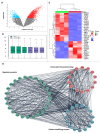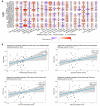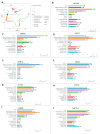Integration of Microarray and Single-Cell RNA-Seq Data and Machine Learning Allows the Identification of Key Histone Modification Gene Changes in Spermatogonial Stem Cells
- PMID: 40282252
- PMCID: PMC12024924
- DOI: 10.3390/biology14040387
Integration of Microarray and Single-Cell RNA-Seq Data and Machine Learning Allows the Identification of Key Histone Modification Gene Changes in Spermatogonial Stem Cells
Abstract
Histone modifications play a critical role in regulating gene expression and maintaining the functionality of spermatogonial stem cells (SSCs), which are essential for male fertility and spermatogenesis. In this study, we integrated microarray and single-cell RNA-sequencing (scRNA-seq) data to identify key histone modification gene changes associated with SSC function and aging. Through differential expression analysis, we identified 2509 differentially expressed genes (DEGs) in SSCs compared to fibroblasts. Among these, genes involved in histone modification, such as KDM5B, SCML2, SIN3A, and ASXL3, were highlighted for their significant roles in chromatin remodeling and gene regulation. Protein-protein interaction (PPI) networks and gene ontology (GO) enrichment analysis revealed critical biological processes such as chromatin organization, histone demethylation, and chromosome structure maintenance. Weighted gene co-expression network analysis (WGCNA) further revealed three key modules of co-expressed genes related to spermatogonial aging. Additionally, ligand-receptor interaction scoring based on tumor microenvironment analysis suggested potential signaling pathways that could influence the stemness and differentiation of SSCs. Our findings provide new insights into the molecular mechanisms underlying SSC aging, highlighting histone modification genes as potential therapeutic targets for preserving male fertility and improving SSC-culturing techniques. This study advances our understanding of histone modification in SSC biology and will serve as a valuable resource for future investigations into male fertility preservation.
Keywords: bioinformatics; gene ontology; germ cell; microarray; spermatogonia stem cell.
Conflict of interest statement
It is declared by the remaining authors that there are no commercial or financial relationships that might conflict with this research.
Figures







Similar articles
-
Integrating Microarray Data and Single-Cell RNA-Seq Reveals Key Gene Involved in Spermatogonia Stem Cell Aging.Int J Mol Sci. 2024 Oct 30;25(21):11653. doi: 10.3390/ijms252111653. Int J Mol Sci. 2024. PMID: 39519201 Free PMC article.
-
Integrated bioinformatics analysis of the transcription factor-mediated gene regulatory networks in the formation of spermatogonial stem cells.Front Physiol. 2022 Dec 8;13:949486. doi: 10.3389/fphys.2022.949486. eCollection 2022. Front Physiol. 2022. PMID: 36569748 Free PMC article.
-
Transcriptome analysis of mouse male germline stem cells reveals characteristics of mature spermatogonial stem cells.Yi Chuan. 2022 Jul 20;44(7):591-608. doi: 10.16288/j.yczz.22-047. Yi Chuan. 2022. PMID: 35858771
-
Current scenario and challenges ahead in application of spermatogonial stem cell technology in livestock.J Assist Reprod Genet. 2021 Dec;38(12):3155-3173. doi: 10.1007/s10815-021-02334-7. Epub 2021 Oct 18. J Assist Reprod Genet. 2021. PMID: 34661801 Free PMC article. Review.
-
Epigenetic Regulation of Spermatogonial Stem Cell Homeostasis: From DNA Methylation to Histone Modification.Stem Cell Rev Rep. 2021 Apr;17(2):562-580. doi: 10.1007/s12015-020-10044-3. Epub 2020 Sep 16. Stem Cell Rev Rep. 2021. PMID: 32939648 Review.
References
-
- Aballa L., Chraa M., Louhab N., Kissani N. Extensive anaplastic multi-centric ependymoma in a young adult: Case report and literature review. Egypt. J. Neurol. Psychiatry Neurosurg. 2023;59:67. doi: 10.1186/s41983-023-00663-1. - DOI
Grants and funding
LinkOut - more resources
Full Text Sources

